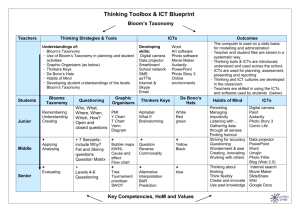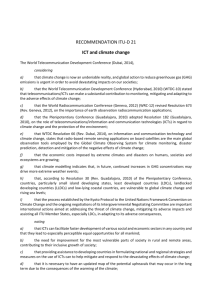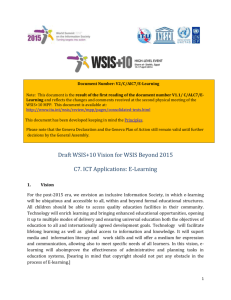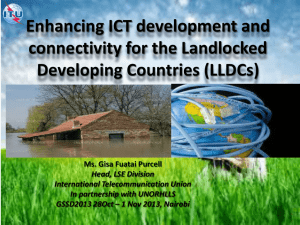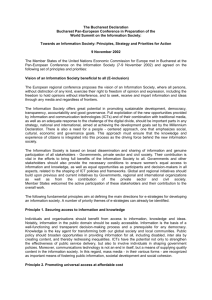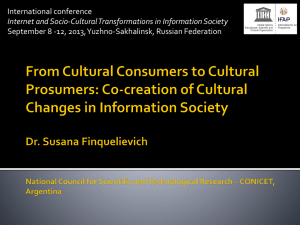Chapter 3 Research Design and Methodology
advertisement
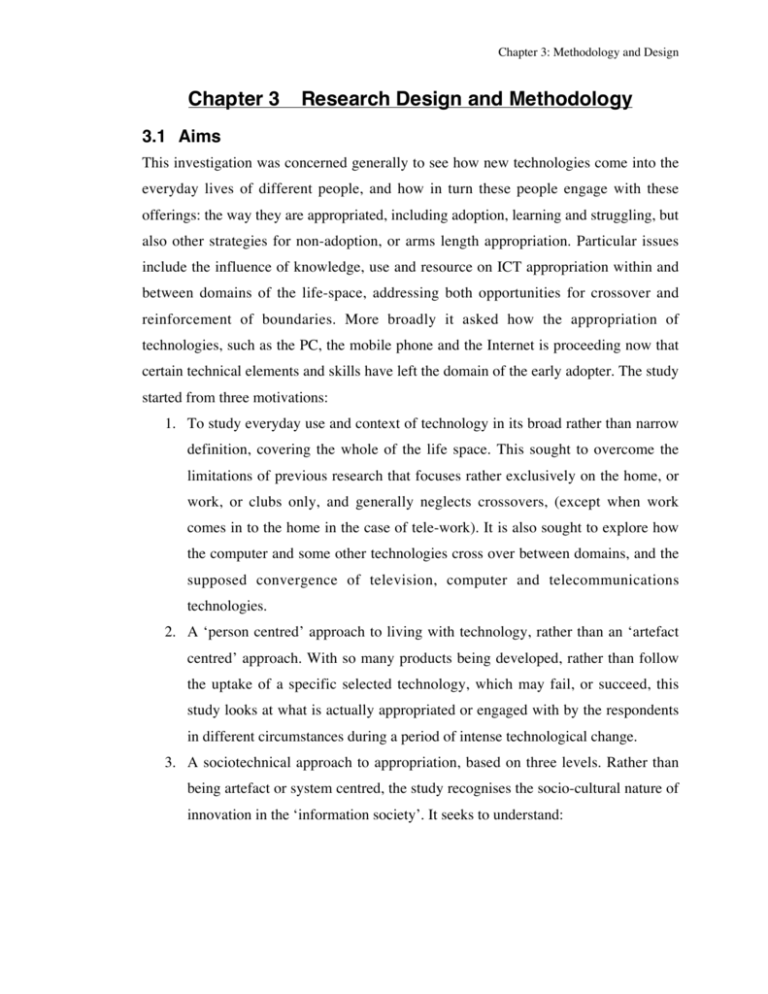
Chapter 3: Methodology and Design Chapter 3 Research Design and Methodology 3.1 Aims This investigation was concerned generally to see how new technologies come into the everyday lives of different people, and how in turn these people engage with these offerings: the way they are appropriated, including adoption, learning and struggling, but also other strategies for non-adoption, or arms length appropriation. Particular issues include the influence of knowledge, use and resource on ICT appropriation within and between domains of the life-space, addressing both opportunities for crossover and reinforcement of boundaries. More broadly it asked how the appropriation of technologies, such as the PC, the mobile phone and the Internet is proceeding now that certain technical elements and skills have left the domain of the early adopter. The study started from three motivations: 1. To study everyday use and context of technology in its broad rather than narrow definition, covering the whole of the life space. This sought to overcome the limitations of previous research that focuses rather exclusively on the home, or work, or clubs only, and generally neglects crossovers, (except when work comes in to the home in the case of tele-work). It is also sought to explore how the computer and some other technologies cross over between domains, and the supposed convergence of television, computer and telecommunications technologies. 2. A ‘person centred’ approach to living with technology, rather than an ‘artefact centred’ approach. With so many products being developed, rather than follow the uptake of a specific selected technology, which may fail, or succeed, this study looks at what is actually appropriated or engaged with by the respondents in different circumstances during a period of intense technological change. 3. A sociotechnical approach to appropriation, based on three levels. Rather than being artefact or system centred, the study recognises the socio-cultural nature of innovation in the ‘information society’. It seeks to understand: Chapter 3: Methodology and Design a) The biographies and appropriation of things or artefacts themselves. b) The biography and appropriation and reinvention of proposed uses, programmes and visions that accompany artefacts. Often a particular technology may fail, but it is only a step on the way to adoption and development of a class of services such as home shopping, or the mobile office, computers in education. In an age of multiple competing technologies and service providers, the class of service is another key level of analysis. Reinvention of services and changes in attitude often occurs ahead of technical innovation, but nevertheless can be seen as part of the innovation process. c) A third level is that of issues on the macro scale, but affect individuals and communities – issues such as privacy, reliance on technology, the effect on the news media, on national identity, the idea of progress through technology etc. This includes “tales of technological utopianism” (Kling and S., 1988) and dystopianism, as well as more concrete issues such as copyright. These may be harder to grasp, but they are central to the idea of the information society, are the subject of extensive academic business and policy work, and are debates that are accessible to everyone. They are also represented by particular products – such as government legislation, which is in its turn ‘consumed’ in its own way. 3.1.1 Research Questions From these general aims, a number of specific research questions and issues emerged and were further refined in the course of developing the research design. The main questions are summarised below: 1. What are the crossovers between work and home and other domains of life in the experience and appropriation of new ICTs? How does technology help break down boundaries, or used to reinforce them? 2. What are the issues that make adoption and use of ICTs difficult, such at they create ambivalence between benefits and problems, and need practical and social resources to cope with them 3. How important is the local social network as resource and factor in the diffusion of technologies, and the appropriation process? (This question was particularly interesting since some of the technologies in question are ‘network’ technologies, and their use depends on having other people to use them with). 4. Why do people not adopt new ICTs that are becoming popular all around them, and what does it mean to be a non-adopter? Can we also ask how people resist technical change? Chapter 3: Methodology and Design These questions throw light on the greater issue of whether we can question an individualistic consumption and ownership model. Two secondary questions that motivated the research, but are not examined in this thesis in details are: 1. How are people experiencing the convergence of technologies, industries etc, and engaging with the industry driven development of new classes of services and uses. Are there types of classes of uses developed by users, or parts of everyday life that are not part of the industry and policy agenda. How are, and may people respond to the key services that are being developed for new technical platforms, and what applications and services appear to be proving most relevant and popular? 2. How do the academic and policy issues around the innovation and appropriation of new ICTs form part of the experience of people not necessarily engaged with them directly? How do these issues become apparent and how do people engage with them? In these questions issues of personal, social, functional and technical ‘context’ is be central. The Social Shaping of Technology perspective suggests a social constructivist perspective on one hand – the way that technologies, uses, concepts and roles are constructed in context and in ‘use’, but on the other hand stresses the influence of the characteristics of the technology, and in this case information and communications, in shaping the meanings and context. While the meanings of technologies may be shaped by the broader social and cultural context, and discourse, the technology itself has a powerful reverse effect. Most studies of technology and innovations have found the same broad trends in use and adoption of ICTs, with age, gender, money and occupation being important predictors of attitudes, use and rate of adoption. Assumptions are made about the difference between the way men and women, or the young and the old, approach technology, and are addressed by industry. However as ICTs become less ‘technological’, and digital computing technology becomes more and more ubiquitous, I wanted to take a critical Chapter 3: Methodology and Design stance, not looking for stereotypes but trying to see from ‘bottom up’ observation how and why there may be different approaches to new ICT between people, based not only on demographics, but also on a range of other influencing factors. Do changes in employment, education and expectations alongside changes in technology challenge our stereotypes of women and men, or the old and the young? In order to tackle this sort of issue I needed to study a number of different milieu, with a range of people of various ages, occupations, resources, attitudes to technology etc, in order to get a range of different examples to compare and contrast. However the number of people I could interview would be limited by my time and the type of research method I chose. 3.2 Designing the Field Work This research design builds on research done into use of technology and media in the home in the various other spaces using a qualitative research method1. This discussion of the methodology attempts to present some of the specific tools and experiences used to inform the design of the research and the development of an interpretation. 3.2.1 Studying the Process of Adoption and Domestication Some studies of technology are aimed at building up a picture of the use of technologies in a social system at a particular time in a generally stable situation. Others investigate the process of domestication from the moment a technology is adopted. The processes leading up to adoption are generally investigated in hindsight. Diffusion studies tend to look in hindsight at the diffusion of an innovation though a community, following one particular technology. Adoption studies, even those concentrating on word-of-mouth, and personal influence, do not look closely at the actual process of interactions in details, and seldom use qualitative research methods. In my research I wanted to look at natural setting over a period of time, to try and see what natural encounters there were with technologies, why and how these occurred, and how people engaged not only with technologies, but with ideas about them too. I wanted to see how people linked innovations into their existing cultural and technical world, how different technologies were interpreted, and how they were appropriated. I wanted Chapter 3: Methodology and Design to uncover this process and seek to understand in the context of the everyday activities, relationships, background and events of the respondent. In particular, I wanted to see how processes within the social network played a role in the way people encountered and coped with innovations. I developed a method of research, many elements of which I were reinforced by observations from number of researchers from different disciplines. Rogers (Rogers and Shoemaker, 1971) suggests that diffusion research needs to be much more processoriented than is general. It should be qualitative, and follow sequences of events over time, to try and get closer to understanding the actually adoption process. He also suggests that instead of focusing on single innovations, we should see them as part of clusters, with adoption of one linked to others, especially when boundaries between technologies is not very clear. These clusters or complexes need to be investigated in an evolutionary sequence. He suggests we have to look for how these links are made by potential adopters, and not rely on the classification of experts. In particular, he suggest not falling for the empty vessel fallacy, assuming that potential adopters do already have the knowledge and skills (“indigenous knowledge systems”) to evaluate and use innovations relevant to their lives. In fact this is the approach of sociology of technology and of consumption – to understand how interpretations of an innovation are arrived at in the culture in which it emerges or is introduced. Developing research out of the consumer research paradigm, Mick and Fournier (Mick and Fournier, 1995) criticise the lack of research that focuses on the on the context of consumption, the pre- and post-adoption aspects of consumption and the role of symbolic. They developed a methodology using phenomenological interviews to give insight into emotional responses, as well as rational explanations given in retrospective interviewing. In particular, they recommend multi-method approaches used in longitudinal inquiries in natural settings (Mick and Fournier, 1998). Moores, who did several details studies of the domestication of radio and satellite TV suggest that future research should look to a range of ICTs, not just media technologies, and look outside the home as well as inside (Moores, 1996). Some have started to do this Chapter 3: Methodology and Design sort of research, such as Frissen and Punie (1998), who study the role of technologies in the lives of busy people. Haddon, who has conducted much research in this field, makes a number of suggestions about the type of research that needs to be done to understand how people are appropriating the Internet (Haddon and Hartman, 1997). These include what the phenomenon symbolises to different people, including concerns that may make them wary; how they first encounter the Internet, what support they have and any problems they face; how it is perceived and maybe used in relation to other technologies and media; and where it can possibly fit into the time structures of households and individuals. (Haddon and Hartman, 1997). Technologies must not only be put in the context of other technologies and the social context, but in terms of the activities that people do to make them relevant and meaningful. It might be more interesting to go beyond what people actually say about the idea of electronic commerce to consider whether current purchasing practices might favour consumption via the Internet. For example, if a particular household only buys goods and services from offices and shops and pays in cash, not even using a credit card, then arguably they are far removed from electronic commerce over the Internet - such a development would be a major new innovation for them. Whereas for someone already tele-shopping by some means, doing so over the Internet is a variation or extension of what is familiar to them. (Haddon and Hartman, 1997). In studying a long term process of adoption, obviously it is important to find out what people actually do in their everyday activities, to understand how particular products, such as home shopping services could be relevant, and how their adoption may correspond to existing practices, or represent radical changes in activities. In some ways we are trying to find out what people might ‘need’, not in terms of specific solutions, but as “an invisible phenomena that can be deduced from the structure of everyday life” (Desjeux, Taponier et al., 1997, p.253). 3.2.2 Focusing on the Life-Space and Technology Venkatesh studied the appropriation of computers in the home and suggests that sociotechnical studies have to “attempt to capture the structure and dynamics of computer adoption and use in the home, by looking at the interaction between the social space in which the family behaviour occurs and the technological space in which technologies are embedded and used.” (Venkatesh, 1996) This is similar to much of the domestication research that tries to understand the structure of the moral economy in the home Chapter 3: Methodology and Design (Silverstone, Hirsch et al., 1992; Silverstone and Hartman, 1998). This involves looking at symbolic and practical structures of the home in terms of time, space, activities, roles, power relations, rules, and use of technologies. Studies of the workplace and computerisation take a similar view, looking to understand not only the formal organisation of work, but also the many informal relationships and activities. The aim is to build a model from the ‘bottom up’ model of “how the user will derive value from the product or service” (Carey and Elton, 1996, p.41/42), how they will make sense of in light of all their experiences across the life-space2. The intention of this study was to link the various domains of life, to study the ‘moral economy’ of both home and the work place, but also through relationships and activities that cross boundaries. Into this study of the greater life-space I needed to study how technologies arrive in this space and how they are domesticated. To do this I had to look at all the domains of activity and types of activity that made up people’s lives, and could be affected by new ICTs. The following figure gives some of the possible areas of application of technology. Chapter 3: Methodology and Design Chapter 3: Methodology and Design 3.2.3 Gaining Access One problem is to gain access to respondents, and the problems of being able to study them, and gain some familiarity with their world, or share their ‘reality’. Social science methodologies propose many different ways in which this can be achieved, and guidance on the extent to which involvement in a respondent’s life world is necessary to for particular descriptive or analytic ends. Practical problems include getting people to speak to the researcher at all, then getting them to be open, co-operative, and sincere in discussing the aspects of their lives that interest the researcher. More fundamental for research methodology is the reliance on the personal descriptions of the respondents, who may either intentionally conceal or mislead the researcher, or unintentionally mislead them. In studying someone’s life world, it is unlikely that the respondent will be able to comprehensively and thoroughly describe not only their opinions and thoughts, but the details of everyday activities and relationships, and the context in which they conduct them, especially in the space of a relatively short interview. Participant observation is a method that tries to surmount these obstacles, but at the expense of huge effort by the researcher, and can only be carried out in a situation where the researcher can actually live or work within a small group over an extended period of time. Since I intended to look at a number of groups, and across the social network of one particular member, this type of methodology is impossible. What is more, gaining access to the work place or social clubs may be possible, but living in private homes is very difficult. Only a few researchers have tried this (for example, James Lull in order to examine media use (Lull, 1990)). I wanted to study the way people encountered new technologies over a period of months or even years, when in fact key events may only occur very infrequently, so this did not make much sense. Other research methods used in media studies include asking the participants to keep diaries. This again is does not get any closer if especially if salient events occur very infrequently and outside the period of research interaction. I wanted to interview not only users of new technology for whom the technology had a direct personal relevance, but also non-users for whom it did not. I expected that during Chapter 3: Methodology and Design the process of research many of the respondents would be likely to encounter and form opinions on new ICTs and have some engagement with the process of innovation and diffusion, however unwillingly. I had to find a method that would enable me to gain access to people who did not have any interest in the subject of research- new media technologies, and who would be difficult to contact or engage with though a research method based on current users. Especially for these people I had to develop a number of tactics to bring out the discussion of new ICTs, and to build an understanding of each person’s life-world and the way that they encountered and engaged with ICT innovations. 3.3 Initial Concept of Research Method Instead of selecting a range of established social groups, say a workplace, a club, a nuclear family, a group of friends, a shopping centre, I decided from the outset to use an Informer approach, taking as my point of entry an individual who would to some extent participate in the research as a co-researcher, and provide entry into their social ‘world’. Blumer suggest that the researcher “seek participants in the sphere of life who are who are acute observers and who are well informed”(Blumer, 1969, p.41). The research design then involved mapping the various other people that these respondents engaged with (both in relation to specific uses of ICTs and more generally) in different domains of their life sphere. I would then conduct interviews with those they work with, their family, their friends, and ask them to report on their experiences of traditional and new media and communication technologies. The Informant, and the others they identified, would not be selected on the basis that they personally use or buy any particular technology – given the symmetry principle that non-use is just as interesting as use. The crucial point is that it is the Informant’s social network and individuals within it that are being studied, not only the key Informants themselves. Whilst the selection of the initial informants would obviously have an important influence over research outcomes, any such shaping by the researcher would then be diffused as the interviews moved out to the networks identified by the Informants. Although such an approach does not Chapter 3: Methodology and Design eliminate the bias inherent in selection of respondents this kind of snowballing method does open up the range of people interviewed. The involvement of the Informant was conceived as being important for practical and theoretical reasons as well - an informant will have to be engaged as a co-researcher who will provide access for the researcher to their social groups. I did not presume that the Informant’s position would be un-problematic, but anticipated that there would be many difficulties with their relationship to the research, and their role in forming the opinions of their groups. In fact the informant role as a point of passage between social groups is very important - however they are unlikely to be unique points of passage in real life. By interviewing a number of people who shared similar experiences and knew each other, or knew a common contact this method would also enable me to compare the experience and interpretations the respondents had of particular events, shared spaces, relationships and each other. This would make the study satisfy some of the basic demands of an ethnographic study. The aim was to conduct this study on a longitudinal basis – with the idea of repeating the fieldwork after maybe 1 year, by which time I expected that there would be appreciable changes in the discourses and use of technology in society in general and in the groups being studied. Interviews were conducted on a semi-structured basis with the help of a schedule of questions and issues (included in the Appendix). I also explored the use of other devices to prompt responses in a less structured way. Having carried out a ‘dummy run’ with these research instruments on friends and fellow students, I then undertook an initial ‘pilot study’ with the first group of interviewees. Since I was attempting an experimental and rather unstructured research design, which potentially threw up further problems, for example in data analysis, the pilot study provided an important opportunity for assessing and refining the research design. Chapter 3: Methodology and Design 3.3.1 Designing the interviews I was not trying to trace the network of influences, but rather study a group of people who interact at home, work and in other social situations, and compare their different approaches and study how they influence each others, and how the influence of third parties is passed on and 'negotiated' in the group. There is no need to do a complete network analysis for this, but in putting together the sample, an informants ego (personal) network is to be the basis for selection. I had to design an interview guide that would investigate the individual’s background, their everyday activities, major and minor events in their lives and their relationships with others. This would include information on activities that are currently the target of the development of ICTs, such as workplace activities, shopping, banking, media, entertainment, communications and information use. I mapped out the range of areas of life that I might have come up in the following Table. I would then focus on the knowledge and use of ICTs and how they were engaging with them. Since I was investigating the adoption process, I also tried to find out how they went about adopting new products, covering information seeking, advice taking, buying, learning etc, for what ever product. This included the importance of different personal relationships in making decisions, finding out information, and forming opinions, compared with reliance on ‘public sources’ such as shops and media. I also asked about broader issues to do with the development of technology and its impact on society, attitudes towards change, and if they had knowledge of in policy issues involved in the ‘information society’. Chapter 3: Methodology and Design The interview was flexible enough to range over issues that the respondents brought up. The main topics covered are in the table. Background, life themes and history Education background Family background Life history Important relationships Resources Everyday activities and recent events Events Life changes Work activities Domestic life 3 Shopping practices Information, Media and Communication Information use and attitude Media use Work communication Friends and family communication ICT use and knowledge ICT use ICT adoption Social Network’s use of ICTs ICT attitudes Engagement with ICTs Knowledge about ICTs Problems with technology Knowledge of implementation of ICTs in government and industry Policy issues on ICTs Table 1 Topics covered in interview schedule 3.3.2 Primary analysis of success of first pilot interviews, and comments for proceeding with concluding research on pilot. The initial respondents were found through an acquaintance, a primary school teacher who agreed to help. She named a colleague and her family as her closest network, whom she shared most things. The details are given in the next chapter. The first set of interviews was conducted in January 1997. All eight interviews were transcribed. The interviews explored the life of the participant - looking at domestic, social, employment, and economic situation, and some life history. It then looked at a number of everyday activities drawn from the original ‘plan for looking’ at new media in everyday life. The interviewing approach started not from technology, but from particular activities, and attitudes towards those activities, the social relations involved, and included instances of specific technologies. The questioning aimed to find out what the important activities, preoccupations and relationships are in the participants’ lives, and their attitudes and practices around them. Then more particular questions were asked about technology in everyday life, based on the earlier remarks of the participant, and introducing new themes. There was not an attempt to get them to define ‘technology’, or Chapter 3: Methodology and Design use my vague definition, but technologies were seen in the context of particular practices, activities and expectations. I was happy with the results of the first interviews. They laid considerable groundwork for asking about the changes in use and expectations about technologies in context over the last year. However I made changes to the question schedule, mostly as a result of how I actually conducted the interviews, but also to reinforce some of the background material. For example, I needed to bring out more details of the relationships between the participants, and ask their opinions on the other’s attitudes to information, technologies and the other activities and interests identified in the research plan. I also asked more about significant others that I was not interviewing, who lay outside the social circle of the principal informant. 3.3.3 Finding and engaging respondents I found the rest of the respondents by focusing on finding principal informants with specific backgrounds that I thought would be interesting in the light of particular interpretations of the technology: these included computer entrepreneurs, artists, senior business managers, students and unemployed teenagers. I also wanted informants who would be interested in the topic and agree to help me persuade their family, colleagues and friends to help me. Through word of mouth and email-lists and a local cybercafe I found three informants who put me in touch with their personal networks. Details of the respondents are given in the next chapter in summary and in the Appendix in much fuller detail. 3.3.4 Conduct of the interviews While I only met most of the respondents for the interviews twice, I spent a considerable amount of time with the Informants. I usually met them once to explain the purpose of the work, and get an idea if they would be interested and willing to help, and also if they could provide me with a network to interview. In particular, I met frequently with the informants in Groups 2 and 3, who were developing very interesting multimedia projects. This included spending the night on the floor of one while visiting his home in Chapter 3: Methodology and Design a snowstorm in the north of Scotland. I visited them where they worked and in their homes for the first and second interviews, and in the case of groups 1and 3, travelled to visit other members of the group with them. I made the interview the focus of a meeting in which I also tried to develop an understanding about how they lived, where they worked, the relationships with others, their interests and engagement with the subject by observation and in conversations around the interview. These conversations were used to make myself feel at home, and to make the respondent realise that I was not coming to grill them about their knowledge of complex technologies, which worried some of them. The conversations also revealed things about their relationships with others in the network, and sometimes raised issues that would not have come out in the rather more formal interview. Coming to the second round of interviews was easier in some respects, probably due to familiarity of the interviewee with me and the process of the interview, and the more relaxed relationship between me and the interviewee However, while some of the respondents had had many experiences with new technologies over the gap, others had had almost none, and could not see the point of the interview. Nonetheless it was important for me to find out why they had not, and find out what they knew about the experiences of others in their network. 3.3.5 Second Stage Empirical Data Collection The Second Interviews focused on current attitudes and use of technology, and investigate experiences and changes in activities, personal situation and technology awareness since the first interview. It looked for the role of others in these experiences. I attempted to get participants to tell more in-depth stories about their encounters with technologies, and the way these experiences were communicated and shared at the time, and subsequently. I also wanted to try some other interview techniques to enriched the research. This is not quite ‘triangulation’ but a way to expand and deepen the understanding, rather than perform any alternative or cross-checking. For this I included interviewing in groups and using pictures to stimulate talk: Chapter 3: Methodology and Design 1. To discover what each participant knows about and is ignorant of, in relation to technological developments that have been announced by the ‘supply side’ of industry and government, particular functions and uses of new media technology, or issues raised by multimedia use. In the first interviews I waited to the very end to ask about awareness of the Internet, Digital TV etc, and offered short explanations if the participant did not know and wanted me to explain. Otherwise I did not. I wished to pursue a similar course this time, finding out how aware of these developments they are today. I used pictures, and scenarios based on their particular ‘life-worlds’. This way I hoped to discover the depth of knowledge, and interest in developments in multimedia. This will enhance my understanding of what technologies or ideas the participant comes into contact with. 2. To investigate the importance of the close social network, and to use it as a reflexive tool to bring out shared experience, and differences in attitudes and knowledge. To do this I interviewed some of the respondents in pairs or group. This was aimed at bringing out stories that did not come up in our individual talks, and to bring up more details about the relationships. It was also an attempt to give me a closer insight into shared experiences around technologies, uses of technology and attitudes including what views are held in common, what has not been shared by the participants, how they rate different sources of information and influence, and their impressions of future developments in new media technology. 3. To investigate the interaction between different areas of everyday life: home, work, social, public, the different relationships with people in these different domains, different communications patterns, and the boundaries created between these areas. 4. To investigate changes in multimedia. Originally the research tried to focus on the aspects of everyday life that the supply industry has been predicting would be affected by new technology: e.g. shopping, information, communication at home and work, a range of work practices and activities, education and training, banking, entertainment etc. The questions explored these areas, focusing in Chapter 3: Methodology and Design advance on the issues that were arising from the supply side agenda, but allowing the respondent space to speak about how new technology was coming into their lives, and look for areas where it might do. Over the time of the research, a great many changes have come about in the use of ICTs - often in areas quite banal, and with unforeseen applications and technologies. The second interviews tried to uncover those experiences, and applications that have developed that are outside the main areas of hype. The interviews looked for ways that new technology came to be judged or coped with. I specifically looked for engagement and utility dimension of relationship to information, communications, learning or entertainment systems. The exercise showing the photographs was somewhat successful, although with some people they had no idea about any of the issues involved. The photos mean that it was easier to introduce the subjects. Sometimes it felt like going over old ground. Doing the interviews in groups led to some more information being divulged and the discussion that ensured were interesting as they revealed differences in knowledge, and attitude between those in the groups, be they a couple, a family etc. 3.4 Analysis of Data I interviewed 29 people in 4 groups, with two sets of interviews, with each interview lasting between one and two hours. Computer-aids were used to assist the management and analysis of the mass of interview transcripts. The first job was to try and extract from this material quotes corresponding to all the issues I had raised, and look for new ideas and issues arising directly from the respondents words. The NUDIST package proved extremely helpful with its powerful facilities for cross-referencing excerpts. Crucial to this is the elaboration of a set of reference terms. I developed a rough set of terms in analysing initial interviews from the first group – and subsequently refined these in the light of a larger number of responses. The aim was to balance on the one hand an openness to a wide range of responses, and on the other the need to group these experiences. This enabled a simultaneous investigation of the data from the ‘bottom up’, i.e. from the interviews themselves, and from the ‘top down’, engagement based on Chapter 3: Methodology and Design themes derived from existing theory and research questions. The categories generated and classified are listed in the Appendix. They proved very helpful in analysis, building up a picture of important dimensions of the experience of ICTs. However, as we see in the detailed empirical chapters, it was necessary to generate further more detailed schema for analysing particular aspects and processes in ICT adoption (and nonadoption). The use of computer-tools allowed considerable flexibility in this respect. These nodes were then linked further together in a number of emerging themes relevant to the network, technology, technology problems and attitudes, non-adoption, adoption, knowledge, communication and information use. Searches of the marked texts enabled groups of quotes reflecting different issues to be bought together quickly. However there was still a need to structure this in a simpler and more straight forward way in order to actually write the stories and compare and contrast experiences. 3.5 BEAN (Background, Events, Activities and Network) To structure the resultant data a framework was needed that would focus on particular dimensions of everyday life relevant to understanding the way that people encounter technologies, think about them, adopt and use them. The approach I chose was to look at the data from four angles: Background or personal history, Events, Activities and the social Network or BEAN to make an easily memorable acronym. This gives a way to assemble the contextual information, and to highlight crossovers and boundaries in the consumption, use and domestication process. It also gives framework for then moving to analysis based on domestication, appropriation, adoption, diffusion, and consumption models. These dimensions are obviously not independent: activities are related to the network, and changes in activities and relationships. Many events could be argued to be particular types of activities that people take part in. Background or Personal History: The respondents all have a history of experiences, of use and adoption of technologies and services that influence their activities and attitudes during the study. The personal history goes beyond this to broader history of relationships, education, and other activities. This dimension includes reflections on the Chapter 3: Methodology and Design life course of the individual or group. It looks at the possibility of personal innovativeness. Events: There are three types of events that influence the adoption and appropriation of innovations: life course events, cyclical events, and one off social events or technological experiences. These events may be periods of considerable length (such as particular project at work, or the learning period for a new innovation). Activities: these describe the spheres of everyday life in which the respondent takes part, such as work, school, family life, community life, and the activities they engage in within those spheres. The use and attitude to information, technologies and communication is examined within the context of these activities. These include work tasks, domestic tasks, leisure activities, media use etc. Activities will reflect, but not be actually linked to the stages of the respondents’ life course. Changes in activities are linked to events. Network: the personal network describes the relationships of the respondent, with whom they share spaces, ideas, decisions, experiences etc. The network is not fixed, but evolves over time. These are now examined in more detail: 3.5.1 Background/Personal History Background and personal history approach looks for the attitudes, experiences, knowledge and motivations of the respondents: Life themes, Motivations, values, attitudes that are broadly continuous during our lives, or through long periods. They include certain ‘psychological’ factors related to ‘innovativeness’, enterpreneurialism, self-centredness etc. outlook on life, attitude towards relationships and community, priorities. At any one time certain themes may be more apparent or easily expressed than at others. They can also develop over time as a result of major events and experiences (e.g. (Douglas and Isherwood, 1979, 1996; Douglas, 1996) and work on lifestyles (Chaney, 1996)). It is not obviously not possible to look at why these exist in detail: where the line between ‘genetic’, early life shaping, and later life changes is, and how we can change ourselves. Past life projects, Past life events: Chapter 3: Methodology and Design The past experiences and events that shape attitudes, knowledge, social network, Knowledge, values, priorities and attitudes: The attitudes and knowledge that are carried forward at each stage of life to the next. Routines, repertoires, habits, beliefs: There is nothing deterministic about the influence of our past on our present, new life projects can draw on this knowledge and experience, but can also be attempts to overcome, change or retreat from aspects of earlier life projects. At the level of technology, media, information and communications there are: ß ß ß ß ß ß Experience of using and seeing technology, personal and vicarious Education in ICT Interest in innovation, new products and services Interest in information about the world Attitudes towards technically mediated or interactive activities. Particular experiences, personal habits and routines, myths and beliefs about ICTs, 3.5.2 Network The personal network is those people we have relationships with in our daily life. It ranges from close and intimate relationships of family friends, through colleagues in ‘public life’ to casual, weak relationships, acquaintances etc. These relationships can be voluntary or obligatory, friendly or hostile, or anywhere in between. Networks associated with life projects e.g. family, work colleagues, friends from other activities Knowledge and resources associated with networks: The network brings with it knowledge and resources, obligations, division of responsibility and resources). Shared myths of social groups in the networks, History of relationships, shared experiences, knowledge of and about those in the network. Symbols with meaning exclusive or special to the network. Cross over of networks. Different networks in our lives can be kept separate or overlap. People have different sorts of networks – strong, close, highly connected, weak and dispersed, radial – an individual is part of several not overlapping networks. Self-perception within network, Relates to our own perception of our place within a network - our status, value, contribution etc. Chapter 3: Methodology and Design Functional and symbolic roles in networks: Responsibilities, status, influence, specialisation, demands. This includes what we do in the network, and how we are respected – the moral and the ‘economic’ roles and the stereotypes and images of others in the networks. At the level of ICTs there are: ß ß ß ß ß People in network who use new technology Those who are trusted and accessible for information and advice Those who are considered examples, opinion leaders Status of technology knowledge and use in a relationship Use of technology in mediating relationships 3.5.3 Activities These are the things we do – they are not always rationally explained by goals, and often emerge from compromises and restrictions, as much as from voluntary choice. Activities include routine ‘everyday’ activities. They include maintain and developing relationships, motivation and goals, actions, consumption, creation and production, communication, and learning. Current life projects The activities that make up and support our life projects i.e. Work status, family status, leisure interests. These life projects are linked closely to life stage. These include all the things we do as part of jobs, studying, maintaining our relationships, managing our home, being a citizen, and a consumer. Childhood Adolescence Leaving home Student Early unemployment 20s Early Family Delayed Single Delayed Family Maturity in work Older children Motherhood Children leaving home Divorce Second Family ‘Empty Nest II’ Early retirement Young elderly Old Elderly Table 2 Possible Life stages Current Goals and motivations: (Why, what) These are specific to life projects and to more general life themes, and are the reasons why we undertake (most of) our activities. Chapter 3: Methodology and Design Priorities and pressures: Limits of time, space, efficiencies sought – we prioritise activities according to pressures and restrictions, often trading off between different demands, projects and motivations. Interactions: Many of our activities are related to our interactions with others: our network Crossover between life projects: Management of boundaries: we have activities aimed at maintaining boundaries between different areas of life, or trying to bridge them. Knowledge associated with activities: Tacit and explicit knowledge related to activities. Myths associated with the activities and the institutions. Knowledge needed to perform activities: At the level of ICTs: ß ß ß ß ß ß ß ß Activities using ICTs Activities where ICTs currently in common use Activities where use of ICTs are currently being innovated Communication circles and patterns Information work – processing information, finding information Education Activities were there is pressure for efficiency improvements Time hungry activities 3.5.4 Events Events are particular sorts of activities that take a short time to achieve and stand out as remarkable against normal activities. They normally involve a change in regular or routine activities and have a significant effect, but can themselves be cyclical or regular as well as unique. Appropriation and domestication process events are very important as they often mark important stages in personalisation, in changing attitudes, in making rules, learning and in changing relationships. Events picked up on in the interviews were those that occurred before or during the period of study. Since this was done by self reporting, only the events that they found significant to the questions (which were varied) were reported. However the questioning was designed to reveal a range of events. Chapter 3: Methodology and Design One class of events I call ‘life events’. I group life events into two categories, major, those that have involve upheaval, and minor, things that may not involve much change, but can be the opportunity or cause of change. Of course there is cross-over, and with hindsight a minor event could be the cause of major change (a new friendship that ends in marriage, or a new interest that leads to a career or major leisure activity). Major life events are events that involve considerable material, relationship and symbolic upheaval. They include marriage, divorce, changing job, major injury, moving house, starting and finishing education, redundancy, entering relationship. How these effect different people is of course a subject for other research, but for my purposes, I see them as important trigger events, and the research shows they can have some considerable effect both in the material acquisition of ICTs. Minor events include minor illness, holidays, buying large items, promotion, making new friends, new activities. Life events: Significant events in life projects – often changing points between one project and a new one. Annual events: Regular practical and symbolic events that are marked by activities of the individual or shared in their group, organisation. Often mark cycles of life, and can be connected to particular life projects. Some may be linked to a subculture, others drawn from more universal culture (public holidays, festivals) Network events: Events that involve the network, these particularly relate to forging or changing relationships. Boundary events: The boundary event initially marks the change from one regime to another, but can also be an event that confirms the boundary when it is challenged. For example, boundaries in relationships, domains in life, the start and end of life projects, the making of rules. Often they are symbolic activities marking other changes (e.g. beating the bounds, initiation rites, and special anniversaries). I also include events that become important in defining boundaries, or for breaking them down: e.g. getting a computer that enables work to be done at home, a decision not to get a computer to keep home and work separate, a family decision to limit TV viewing for children. Appropriation events: Chapter 3: Methodology and Design Related to technology events – but particularly to do with the adoption of new innovations, and important events in the appropriation and integration of them. Technology events: Remarkable events with the use and adoption of technology, maybe a number of small events that are linked together in the mind of the respondent. One of the problems of one-off interviews is to try and understand how people change their minds, and when. One model would be to assume that there are specific events or experiences during which people either gain information, or have to make decisions and analyse and take evaluate that information or knowledge according to their values, circumstances, goals, relationships and resources. However, under this model how ‘large’ or explicit are these events. For some people there may be definite times when decisions or knowledge and attitude formation, affirmation or change occurred. For others there may be a slow accumulation of knowledge, through minor events, or for example, constant use of a technology. Any event may also only be a marker or a crisis point in some underlying situation, something that is the cummulation of chronic problems, or a trigger that tips the balance in favour of adoption. Equally there may be a decision against adoption. A vaguely neutral or negative position may be crystallised by a particular event. Sometimes it is an event from outside (e.g. the arrival of a bill), or an individual deciding that enough is enough. 3.5.5 BEAN and models of consumption and Domestication The analysis was helped by linking the BEAN framework to two other analytic frameworks, the domestication model and the consumption model of Holt (1995). By working with these I was able to derive grid indicating a range of issues to look for in relation to how people used and interpreted ICTs both in use and in the process of domestication. Again, these were used as a guide in the analysis of the data, rather than as boxes to be filled in from to illustrate every possible combination. Chapter 3: Methodology and Design Activities Experience mediated by work, domestic, leisure, social activities Network Experience in context of other people – their influence. Events Context or trigger for adoption shapes experience Personal History Attitudes built over time and experience Integration Integration of ICTs through everyday activities. Meanings through using/doing Integration in a social space (moral economy) Meanings through sharing.? Appropriation at a time of change. Integration work time learning Classification Classification against other specialities in institutions Others to classify oneself with and against in relation to ICTs Play Activities that are shared around ICT use, maintenance, purchase etc The people with whom innovations, adoption, use are shared. Developing relationships around ICTs Bring into contact with new people, obliged to reconsider identity Shared events Personal capacity to appropriate and personalise ICTs and innovations developed through experience (scripts, creativity) Attitudes to others v.v. ICTs developed over time and experiences Experience (Subjective) Table 3 The BEAN approach and. Holt's consumption model Past experiences of using and adopting innovations and ICTs Chapter 3: Methodology and Design Appropriation Objectification Activities Network Events Personal History Appropriation imposed from outside, or seen as fitting activities of household – from work to media use. Activities enable appropriation (resources, money, knowledge) Object brought into the home and placed relevant to activities intended for: work, play, individual or group use. Discussion, debate within household, and with, networks outside – enrolling expertise, and resources Event for whole household – e.g. moving, or for individual e.g. new job, school. Or regular event, e.g. Christmas. Media event Past experiences of ICTs in the home, and the experiences of individuals appropriating from outside Debate over where it should be placed, in what context, how it can be moved. Who is in control; Who is expert set. Discussions of new acquisition Routines of sharing, Emerging rules of use, disputes over use, sharing, discussion integrated into routines, everyday life. Changing relationships of control, expertise. Tool to challenge or re-enforce. Bringing knowledge, attitudes from outside network in, developing knowledge that is translated out again. Attitudes of those outside. Changing boundaries. Others come into to use… Conflict over changing boundaries The installation event, ceremony, the gift giving event, Previous experience with ICTs of different sorts, Breaking points, rule making points, particular events demanding use, decisions to restrict, change use, upgrade, Attitudes to others v.v. ICTs developed over time and experiences. Preexisting routines how they fit new acquisition, preexisting hierarchies Events: use of ICT for/by people from outside. Particular discussions outside home, experiences outside that are brought in, real or electronic. Willingness to share home experience with outside, pre-existing relationships with outside. Incorporation Integration into the activities in the home, routines of space and time - changes in activities Changing existing routines and activities (e.g. displacement, replacement of activities) Conversion Changing boundary of activities. Use of ICT at home that change outside activities (e.g. work routines) bring activities into the home – e.g. socialising in home, electronic or ‘real’. Reinforcement of boundary. Table 4 The BEAN approach and the domestication model 3.6 Preparative Work and Reflections on the Research Process In preparing the research, and developing an understanding of the process I would be investigating in others, I reflected on my own experience and everyday life, using a number of the tools from the literature and those I was developing myself. As I Chapter 3: Methodology and Design developed the research from the original rather different conception, and noticed a number of issues that would subsequently become important. These tools included keeping a diary of my own social network and contacts, and a diary of my own adoption of the mobile telephone, in the context of the issues raised by the BEAN, Domestication and Consumption models, recording my own subjective reactions and thoughts and learning, the practical aspects of learning and using a mobile phone, particular events, and the reactions of other others over a period of two years (These are given in the Appendix). This gave considerable insights into a personal technology that created ambivalence and crossed over into all domains of life, and into the way I could engage with those I was interviewing, and the sort of issues I would have to investigate. Finally, in parallel to the formal research, I was continually watching the way I saw people using and talking about new ICTs, and asking for stories, which were usually forthcoming in response to finding out what I was investigating. These stories reinforced what I was finding in the interviews, and in many ways pushed the direction of the research. One aspect was constant trade in ICTs between people, gifts, sharing etc. Second was the importance of individuals who were enthusiasts and earlier adopters in their social networks, who provided resources, help and encouragement for others. This was true for groups of experienced users, who needed someone to keep them updated on new technology, and for novices who needed a first step on the ladder. Third were the constant problems that were encountered, and the stress that went along with the benefits of use. A number of events also prompted and encouraged my research. One of these was a major trial in the US of an English au pair accused of murdering a child in her care. At the time of the judgement the judge chose to put the verdict on the Internet. He did this not out because the Justice Department had instigated it as a policy, but because his son had persuaded him it was an good thing to do. This was a very public demonstration of the cross-over of influence between home and work in the adoption of the Internet. Chapter 3: Methodology and Design 1 Interpretative or ‘qualitative’ research, developed in the 20th century based on the ethnographic research of the Chicago school, especially George Herbert Mead. Herbert Blumer, who developed the ideas of Symbolic Interactionalism based on the work Mead suggests “The task of scientific study is to lift the veils that cover the area of group life that one proposes to study” (Blumer, 1969)p.39. Interpretative research stresses the importance of the individual and intersubjective interpretation in understanding social processes, but also in the actual practice of social science – there is the’ double hermeneutic’ (Giddens 1976) of the researcher interacting and interpreting Mead (1934) in (Prus, 1996)) the social situation that is being studied. The ethnographic method calls for the researcher to put themselves in the shoes of the other person (Berger and Luckmann, 1966), to share the reality of the ‘life-world’ of the other. Although a theoretical basis is important, the researcher should use ‘inspection’ with a great deal of flexibility to investigate presumptions. The social situation should be approached from different angles and be imaginative, free, flexible, creative. Interpretative research stresses the importance of the individual and intersubjective interpretation in understanding social processes, but also in the actual practice of social science – there is the’ double hermeneutic’ (Giddens 1976) of the researcher interacting and interpreting (Mead (1934) in (Prus, 1996)) the social situation that is being studied. However, what ever the lengths a researcher may go to take the other’s stand point they are inevitably going to interpret the social situation according to a formal and informal logic that they bring to the research process. What a researcher should do therefore is to try and make explicit both to themselves, and to their readers is not only the theoretically imposed interpretative window or frame, but the emotional, personal and contingent influences on their interactions with the those whose lives that are studying and on the interpretative process. 2 Desjeux et al. (Desjeux, Taponier et al., 1997) suggest four main dimension of investigation of the everyday to investigate the link between the social and the technical : Delegation of responsibility, to machines, to other people in the social network, and to commercial providers; Routines; Planning of activities; Improvisation. 3 Shopping is an area where there is considerable promise for new technology for home shopping, information gathering etc. There are very different types of use of technology in different retail outlets and for different goods, and different goods lend to mail order etc. Mail order is also an established business used by may people, from books and CDs, to clothes, consumer electronics, white goods, almost anything. The mail order market serves different groups. Catalogues that sell a wide range of goods are generally providing a planned credit service for low income purchasers. Other products such as books and music are sold though clubs and mail order because overheads are lower, and they service a regular purchasing habit. They can also provide a greater choice, and operate on lower overheads than high street retailers. There are specialist mail order services for products that are not normally available except in specialist shops, and mail order companies can offer better prices based on lower overheads and economies of scale from a country wide or global market. There are also more and more single range or brand name mail order services from high street retailers and others, for whom mail order is a form of direct marketing. They run services as a complement to high street operations. Mail order and use of direct marketing information resources has been a big area of development in multimedia around mass market e-commerce


